 RDL Homepage |
 Table of Contents |
 Document Information |
 Download Instructions |
 RDL Homepage |
 Table of Contents |
 Document Information |
 Download Instructions |
| Aptitude for war is aptitude for movement. |
| Napoleon I, Maxims of War, 1831 |
Troop movement is the movement of troops from one place to another by any available means. The ability of a commander to posture his force for a decisive or shaping operation depends on his ability to move that force. The essence of battlefield agility is the capability to conduct rapid and orderly movement to concentrate the effects of combat power at decisive points and times. Successful movement places troops and equipment at their destination at the proper time, ready for combat. The three types of troop movement are administrative movement, tactical road march, and approach march.
14-1. Troop movements are made by foot marches, motor transport, rail, water, air, and various combinations of these methods. The method employed depends on the situation, the size and composition of the moving unit, the distance the unit must cover, the urgency of execution, and the condition of the troops. It also depends on the availability, suitability, and capacity of the different means of transportation. Troop movements over extended distances have extensive logistics considerations.
14-2. Dismounted marches, also called foot marches, are movements of troops and equipment, mainly by foot, with limited support by vehicles. They increase the number of maneuver options available to a commander. Their positive characteristics include combat readiness-all soldiers can immediately respond to enemy attack without the need to dismount, ease of control, adaptability to terrain, and their independence from the existing road network. Their limitations include slow rate of movement and increased personnel fatigue-soldiers carrying heavy loads over long distances or large changes in elevation get tired. A unit conducts a dismounted march when the situation requires stealth, the distance to travel is short, transport or fuel is limited, or the situation or terrain precludes using a large number of vehicles. (FM 3-25.18 has more information on the techniques and procedures for conducting dismounted marches.)
14-3. A unit conducts mounted marches when it employs combat and tactical vehicles to move all of its personnel and equipment. Armored and mechanized units routinely conduct mounted marches. The speed of the march and the increased amounts of supplies that can accompany the unit characterize this march method. Heavy maneuver units are normally self-sufficient to conduct mounted marches over short distances. Light maneuver units and most combat support (CS) and combat service support (CSS) units are not completely motorized and need assistance from transportation elements to conduct mounted marches. Considerations for mounted marches over extended distances include:
The ability of the route network to support the numbers, sizes, and weights of the tactical and combat vehicles assigned to or supporting the unit making the move.
Available refueling and maintenance sites and crew-rest areas.
The need for recovery and evacuation assets.
(FM 4-01.30 discusses considerations for mounted marches.)
14-4. Army air movements are operations involving the use of utility and cargo rotary-wing assets for other than air assaults. The commander conducts air movements to move troops and equipment, to emplace systems, and to transport ammunition, fuel, and other high-value supplies. He may employ air movements as a substitute for a ground tactical movement. Army air movements are generally faster than ground tactical moves. The same general considerations that apply to air assault operations also apply to Army air movements. (See Appendix C for air assault operations. See FM 3-04.113 for additional information concerning air movement.)
14-5. Tactical forces can use rail and water modes to conduct troop movement if they are available within an area of operations (AO). Their use can provide flexibility by freeing other modes of transport for other missions. Their use normally involves a mixture of military and commercial assets, such as defense freight railway interchange railcars pulled by privately owned diesel-electric engines to transport tanks along railroad right of ways from one rail terminus to another. Responsibility for coordinating the use of railroads and waterways resides within the ARFOR headquarters within the theater of operations. (FMs 4-01.41 and 4-01.50 provide additional information concerning these two transportation modes.)
14-6. In cases of tactical necessity, a unit can accelerate its rate of movement by conducting a forced march so that it arrives at its destination quickly. Both heavy and light units can conduct a forced march. Forced marches require speed, exertion, and an increase in the number of hours marched or traveled by vehicles each day beyond normal standards. Soldiers cannot sustain forced marches for more than a short period. In a forced march, a unit may not halt as often nor for as long as recommended for maintenance, rest, feeding, and fuel. The commander must understand that immediately following a long and fast march, his soldiers and combat vehicles experience a temporary deterioration in their physical condition. The combat effectiveness and cohesion of his unit also temporarily decreases. His plan must accommodate the presence of stragglers and address the increased number of maintenance failures.
14-7. Administrative movement is a movement in which troops and vehicles are arranged to expedite their movement and conserve time and energy when no enemy interference, except by air, is anticipated (JP 1-02). The commander conducts administrative movements only in secure areas. Examples of administrative movements include rail and highway movement within the continental United States. Once a unit deploys into a theater of war, administrative movements are the exception, not the norm. Since these types of moves are nontactical, the echelon logistics officer (the G4 or S4) usually supervises the moves. (FM 4-01.40 discusses administrative movement and convoy planning.)
14-8. A tactical road march is a rapid movement used to relocate units within an area of operations to prepare for combat operations (FM 3-0). Security against enemy air attack is maintained and the unit is prepared to take immediate action against an enemy ambush, although contact with enemy ground forces is not expected.
14-9. The primary consideration of the tactical road march is rapid movement. However, the moving force employs security measures, even when contact with enemy ground forces is not expected. Units conducting road marches may or may not be organized into a combined arms formation. During a tactical road march, the commander is always prepared to take immediate action if the enemy attacks. (See Figure 14-1, page 14-4.)
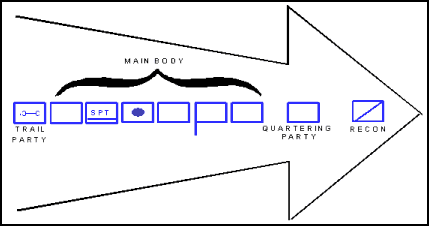
Figure 14-1. Tactical Road March
14-10. The organization for a tactical road march is the march column. A march column consists of all elements using the same route for a single movement under control of a single commander. The commander organizes a march column into four elements: reconnaissance, quartering party, main body, and trail party. A brigade conducting a tactical road march is an example of a march column. The subordinate elements of a march column are a march serial and a march unit. A march serial is a major subdivision of a march column that is organized under one commander who plans, regulates, and controls the serial. An example is a battalion serial formed from a brigade-size march column. A march unit is a subdivision of a march serial. It moves and halts under the control of a single commander who uses voice and visual signals. An example of a march unit is a company from a battalion-size march serial.
14-11. A march column provides excellent speed, control, and flexibility, but sacrifices flank security. It provides the ability to deploy forces to the front of the column. The commander uses a march column when speed is essential and enemy contact is unlikely. However, the commander spaces combat support (CS) elements, such as air defense and engineers, throughout the column to protect and support the movement. Reconnaissance elements augmented by engineer, nuclear, biological, and chemical reconnaissance, and other CS assets, as appropriate, conduct a route reconnaissance of the march routes. This reconnaissance confirms and supplements the data obtained from map studies and other headquarters.
14-12. A unit quartering party usually accompanies the reconnaissance effort to the designated assembly area (AA). Unit standing operating procedures (SOP) establish the exact composition of the quartering party and its transportation, security, and communications equipment needs, and its specific duties. The quartering party secures, reconnoiters, and organizes an area for the main body's arrival and occupation. It typically reconnoiters and confirms the tentative locations selected by the commander of its parent element, based on a map reconnaissance. When necessary, the quartering party changes previously assigned unit locations within the AA. The quartering party guides the main body into position from the release point (RP) to precise locations within the AA.
14-13. The main body of the march column consists of the remainder of the unit, including attachments minus the trail party. The trail party is the last march unit in a march column and normally consists of primarily maintenance elements in a mounted march. It maintains communications with the main body. The function of the trail party is to recover disabled vehicles or control stragglers in a dismounted march. If the trail party cannot repair a disabled vehicle immediately, it tows the disabled vehicle and moves its crew and passengers to a unit maintenance collection point (UMCP) located at a secure area near the movement route.
14-14. The commander directing a tactical road march often uses a strip map or overlay to graphically depict critical information about the route to his subordinates. The overlay or strip map should show the route of march, start points (SPs), RPs, checkpoints, critical points (such as bridges), light line, and traffic control points (TCPs). (See Figure 14-2.) Other graphic control measures include AA sand phase lines.
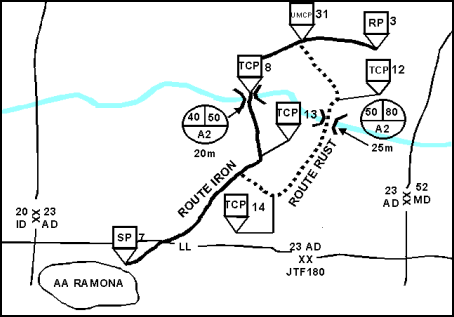
Figure 14-2. Route Control Measures
|
14-15. The start point is a location on a route where the marching elements fall under the control of a designated march commander. Figure 14-3 shows SP 7. All routes must have a designated SP and it must be easily recognizable on the map and on the ground, such as a road junction. It must be far enough from the AA to allow units to organize and move at the prescribed speed and interval when they reach the SP.
14-16. A release point is a location on a route where marching elements are released from centralized control. Figure 14-4, page 14-6, shows RP 11. Each SP must have a corresponding RP, which must also be easy to recognize on the ground. Marching units do not stop at the RP; instead, as they move through the RP, unit guides meet each march unit and lead it to AAs.
14-17. The commander designates checkpoints along the route to assist marching units in gauging their compliance with the timetable. Also, the movement overlay identifies critical points along the route where interference with movement might occur. The commander positions manned TCPs along the route to prevent congestion and confusion. They may be manned by MPs or unit personnel. These soldiers report to the appropriate area movement control organization when each convoy, march column, and march serial arrives at and completes passage of its location.
14-18. A light line is a designated phase line, forward of which vehicles are required to use blackout lights during periods of limited visibility. Commanders at either corps or division echelon establish it based on the risk that the enemy will be able to detect moving vehicles using white light. Figure 14-5 depicts the light line for the 2nd Armored Division as the division rear boundary. (FM 4-01.40 details other march control measures, such as the bridge classification symbols depicted in Figure 14-2.)
14-19. Units conducting tactical road marches employ three tactical march techniques: open column, close column, and infiltration. Each of these techniques uses scheduled halts to control and sustain the road march. The factors of METT-TC require adjustments in the standard distances between vehicles and soldiers. During movement, elements within a column of any length may encounter many different types of routes and obstacles simultaneously. Consequently, parts of the column may be moving at different speeds, which can produce an undesirable accordion-like effect. The movement order establishes the order of march, rate of march, interval or time gaps between units, column gap, and maximum catch-up speed. Unless the commander directs them not to do so for security reasons, march units report when they have crossed each control point. During the move, the commander maintains air and ground security.
14-20. In an open column, the commander increases the distance between vehicles and soldiers to provide greater dispersion. The vehicle distance varies from 50 to 100 meters, and may be greater if required. The distance between dismounted soldiers varies from two to five meters to allow for dispersion and space for marching comfort. Any distance that exceeds five meters between soldiers increases the length of the column and hinders control. The open column technique is normally used during daylight. It may also be used at night with infrared lights, blackout lights, or passive night-vision equipment. Using an open column roughly doubles the column's length and thereby doubles the time it takes to clear any given point when compared to a close column. The open column is the most common movement technique because it offers the most security while still providing the commander with a reasonable degree of control. In an open column, vehicle density varies from 15 to 20 vehicles per kilometer. A single light infantry company, with intervals between its platoons, occupies roughly a kilometer of road or trail.
14-21. In a close column, the commander spaces his vehicles about 20 to 25 meters apart. At night, he spaces vehicles so each driver can see the two lights in the blackout marker of the vehicle ahead. The commander normally employs a close column for marches during darkness under blackout driving conditions or for marches in restricted terrain. This method of marching takes maximum advantage of the traffic capacity of a route but provides little dispersion. Normally, vehicle density is from 40 to 50 vehicles per kilometer along the route in a close column.
14-22. The dismounted equivalent to the close column is a limited-visibility march. The distance between individual soldiers is reduced to one to three meters to help maintain contact and facilitate control. Limited-visibility marches are characterized by close formations, difficult command and control (C2) and reconnaissance, a slow rate of march, and good concealment from enemy visual observation and air attack.
14-23. The commander dispatches vehicles in small groups, or at irregular intervals, at a rate that keeps the traffic density down and prevents undue massing of vehicles during a move by infiltration. Infiltration provides the best possible passive defense against enemy observation and attack. It is suited for tactical road marches when there is enough time and road space and when the commander desires the maximum security, deception, and dispersion. The disadvantages of an infiltration are that more time is required to complete the move, column control is nearly impossible, and recovery of broken-down vehicles by the trail party is more protracted when compared to vehicle recovery in close and open columns. Additionally, unit integrity is not restored until the last vehicle arrives at the destination, complicating the unit's onward deployment. Infiltration during troop movement should not be confused with infiltration as a form of maneuver as discussed in Chapter 3.
14-24. During extended road marches, halts are necessary to rest personnel, service vehicles, and adjust movement schedules as necessary. The march order or unit standing operating procedures (SOP) regulates when to take halts. In motor movements, the commander schedules short halts for every two to three hours of movement and may last up to an hour. Long halts occur on marches that exceed 24 hours and last no more than two hours. Long halts are not scheduled at night, which allows maximum time for night movement. During halts, each unit normally clears the march route and moves to a previously selected AA to prevent route congestion and avoid being a lucrative target. Units establish security and take other measures to protect the force. Unit leaders receive prompt notification of the time and approximate length of unscheduled halts.
14-25. The commander emphasizes the need to maintain security during halts. Once a unit stops moving, there is a natural tendency for soldiers to let their guard down and relax their vigilance. The commander addresses this problem by explicitly defining unit actions in his SOP for various types of halts, such as maintenance halts, security halts, and unexpected halts.
14-26. An approach march is the advance of a combat unit when direct contact with the enemy is intended (FM 3-0). However, it emphasizes speed over tactical deployment. Both heavy and light forces conduct tactical road marches and approach marches.
14-27. The commander employs an approach march when the enemy's approximate location is known, since it allows the force to move with greater speed and less physical security or dispersion. (See Figure 14-6.) Units conducting an approach march are task-organized before the march begins to allow them to transition to an on-order or a be-prepared mission without making major adjustments in organization. For example, artillery units march within their supported unit's columns, while engineer units are well forward to facilitate mobility. Air defense units may leapfrog short-range and medium-range assets to ensure continuous coverage. The approach march terminates in a march objective, such as an attack position, AA, or assault position, or can be used to transition to an attack. Follow-and-assume and reserve forces may also conduct an approach march forward of a LD.
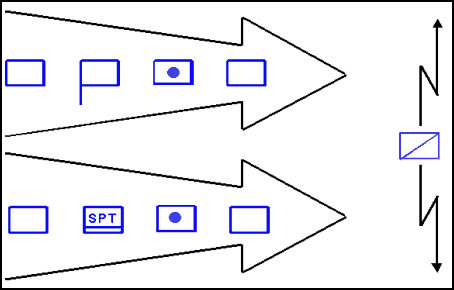
Figure 14-6. Approach March
14-28. Based on the products of his intelligence preparation of the battlefield (IPB) process, the overall commander should assign an AO or an axis of advance in combination with routes to the unit conducting the approach march. These routes, AOs, or axes should facilitate the force's movement and maximize its use of available concealment. Within the approach march, the commander should assign the force conducting the decisive operation and forces conducting each shaping operation separate routes, AOs, or axes of advance unless an individual unit has the task of either follow-and-assume or follow-and-support.
14-29. As the approach march nears areas of likely enemy interference, the commander divides his main body into smaller, less vulnerable columns that move on additional multiple routes or cross-country while continuing to employ security elements. The commander takes advantage of successful reconnaissance and security operations to increase the distance traveled before the main body must transition to a tactical formation. As discussed in Chapter 12, the advance and any flank guards remain within supporting distance of the main body, which stays in these smaller columns to facilitate rapid movement.
14-30. Tactical road marches and approach marches occur within a theater of war when contact with the enemy is possible or anticipated. This style of movement emphasizes tactical considerations such as security and de-emphasizes efficiency and ease of movement. The commander organizes his unit to conduct combat operations in a tactical movement. A unit generally maintains unit integrity throughout its movement. It plans for enemy interference either en route to or shortly after arrival at its destination. Units conducting either a tactical road march or an approach march use formations and techniques consistent with the factors of METT-TC. The unit may conduct them over unsecured routes if there are no friendly forces between the foremost elements of the moving force and the enemy. The echelon operations officer (the G3 or S3) is the primary staff officer responsible for planning these tactical movements, with input from other staff members.
14-31. There are several differences between an approach march and a tactical road march. A force conducting an approach march employs larger security forces because of its greater exposure to enemy attack. Units conducting an approach march arrange their systems into combined arms organizations. An approach march allows the commander to disperse his task-organized force into a tactical formation in unrestricted terrain without being constrained to existing roads and trails. On the other hand, road marches can organize their columns for administrative convenience; for example, vehicles of similar type, speed, and cross-country capabilities move together. Units conducting an approach march establish appropriate tactical intervals between vehicles; they do not normally employ a close column. They also use more routes than units conducting road marches.
|
14-32. The commander uses the combat formations described in Chapter 3 in conjunction with three movement techniques: traveling, traveling overwatch, and bounding overwatch. Figure 14-7 on page 14-10 shows when a unit is most likely to use each technique.
14-33. Movement techniques limit the unit's exposure to enemy fire and position it in a good formation to react to enemy contact. The commander selects the appropriate movement technique based on the chance of enemy contact. While moving, individual soldiers and vehicles use the terrain to protect themselves anytime enemy contact is possible or expected. They use natural cover and concealment to avoid enemy fires. The following rules apply to soldiers and vehicle crews using terrain for protection:
Do not silhouette yourself against the skyline.
Cross open areas quickly.
Do not move directly forward from a concealed firing position.
Avoid possible kill zones because it is easier to cross difficult terrain than fight the enemy on unfavorable terms.
Avoid large, open areas, especially when they are dominated by high ground or by terrain that can cover and conceal the enemy.
Take active countermeasures, such as using smoke and direct and indirect fire, to suppress or obscure suspected enemy positions.
14-34. The commander uses the traveling movement technique when speed is necessary and contact with enemy forces is not likely. All elements of the unit move simultaneously. The commander or small-unit leader locates where he can best control the situation. Trailing elements may move in parallel columns to shorten the column and reaction time. (See Figure 14-8.)
14-35. The commander uses the traveling overwatch movement technique when contact with enemy forces is possible, but speed is important. The lead element is continuously moving, while the trailing elements move at variable speeds, sometimes pausing to overwatch movement of the lead element. (See Figure 14-9.) The trailing elements key their movement to the terrain, overwatching from a position where they can support the lead element if it engages the enemy. The trailing elements overwatch from positions and at distances that will not prevent them from firing or moving to support the lead element.
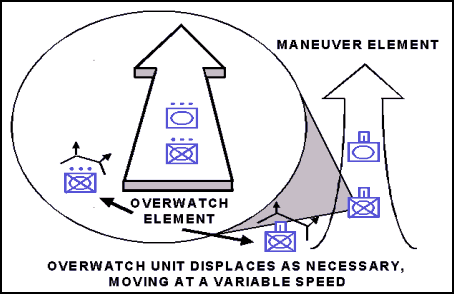
Figure 14-9. Traveling Overwatch
14-36. The commander uses the bounding overwatch movement technique when he expects to make contact with enemy forces. There are two variations of this technique: alternate bounds and successive bounds. In both cases, the overwatching elements cover the bounding elements from covered, concealed positions with good observation and fields of fire against possible enemy positions. They can immediately support the bounding elements with maneuver or fires alone if the bounding elements make contact. Unless they make contact en route, the bounding elements move via covered and concealed routes into the next set of support-by-fire positions. The length of the bound is based on the terrain and the range of overwatching weapons. The commander can use the uncommitted part of the force whenever he feels it is needed as part of an immediate and controlled reaction to any threat to the bounding force. In bounding overwatch, all movement keys on the next support-by-fire position, which should offer at least some of the following advantages:
Cover and concealment.
Good observation and fields of fire.
Protection for stationary weapon platforms.
14-37. If the unit uses alternate bounds, the lead element moves forward, halts, and occupies a support-by-fire position that is covered at all times by the rear overwatching element. That former rear overwatching element advances past the former lead element and takes an overwatch position. The initial lead element then advances past the initial trail element and occupies a new support-by-fire position. One element moves at a time. This method is usually more rapid than successive bounds. (See Figure 14-10.)
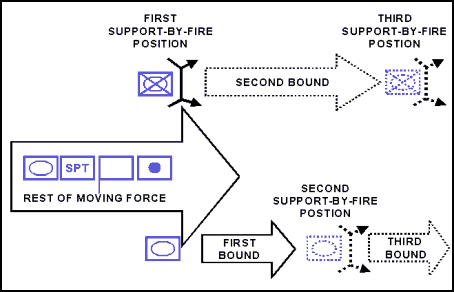
Figure 14-10. Bounding Overwatch—Alternate Bounds
14-38. If the unit uses successive bounds, the lead element, covered by the trail element, advances and occupies a support-by-fire position. The trail element advances to a support-by-fire position abreast of the lead element and halts. The lead element moves to the next position and the move continues. Only one element moves at a time, and the trail element avoids advancing beyond the lead element. (See Figure 14-11.)
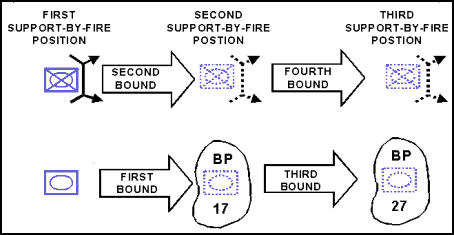
Figure 14-11. Bounding Overwatch—Successive Bounds
14-39. The commander plans, prepares, executes, and assesses troop movements to ensure the organized and uninterrupted flow of tactical units throughout the AO. The objective of a successful move is for the unit to arrive at its destination in a condition suitable to its probable employment. The goal of all movement planning is to retain flexibility to execute a variety of plans to meet ever-changing conditions. The commander ensures that his unit's movement SOP contain specifics, and he conducts rehearsals to ensure that his soldiers and subordinate leaders understand them. The SOP should use a standard task organization to simplify planning, provide flexibility, and allow greater responsiveness. Such SOP allow for smoother cooperation by establishing habitual relationships between the unit's subordinate elements and outside supporting elements.
14-40. The movement order is the end result of the commander's planning process. The movement order is prepared as an annex to an operations order (OPORD) or as a separate OPORD. Prepared in a five-paragraph format, it consists of critical information needed by a unit to plan and execute the movement. Information normally found in the movement order includes the destination, routes, orders of march, rates of march, times that each serial (or march element for serial movement orders) will arrive and clear its SP, intervals, speeds, scheduled maintenance halts, communications, and location of the commander. The commander should also identify logistics sites and services in his movement order. He need not include information and procedures contained in movement SOP in the movement order. The movement order should include a strip map or overlay. (The format for a movement order is covered in FM 5-0.)
14-41. The commander bases his movement order on the best available information on the enemy, terrain, weather, unit capabilities, and civil considerations. This plan establishes how the unit will move from its current location to the desired location. The integration of and support from combat and CS-such as artillery, air defense, intelligence, military police, and engineers-are critical for a successful tactical movement. The commander's operations staff develops the detailed movement order, with the assistance of the commander's logistics staff, in accordance with his established priorities.
14-42. The movement order and unit SOP must address the possibility of ambushes, indirect fires, and air attacks. A small-unit SOP includes drills for reacting to these circumstances. Passive measures to mitigate the effects of an air attack include route selection, vehicle intervals, and movement during limited visibility. In case of attack, the commander has an evacuation plan for casualties. This plan takes into account SOP items, such as using combat lifesavers and dispersing medical evacuation assets throughout the convoy.
14-43. For units that are not 100-percent mobile in organic vehicles, such as a corps headquarters and many CSS units, the commander can either conduct a shuttle with organic vehicles or request assistance from transportation units. Shuttling requires transporting troops, equipment, and supplies by a series of round trips with the same vehicles. It may also be performed by carrying successive parts of a load for short distances while the remaining soldiers continue on foot.
14-44. The higher headquarters logistics staff normally coordinates the provision of logistics support to moving units, although units carry sufficient fuel and lubricants in their unit trains to conduct local movements. In coordination with the engineers, the logistics staff ensures that routes are adequate to support the movement of the types and numbers of vehicles and supplies projected for movement. The commander must be aware of the load-carrying capability of each route and the distances over which forces can be supported. His logistics operators determine if any logistics assets should displace to support the mission. The commander also establishes halts for refueling as part of his movement plan. Halt times should be long enough and locations large enough to allow the entire march unit to refuel.
14-45. The simplest troop movement scenario to plan and conduct is one where the commander directing the movement controls the entire AO. In this situation, he can use his normal C2 system. The headquarters ordering the tactical road march schedules the movement times and approves the routes, while its movements control organization allocates the required space and time on the approved routes. If the movement results in a unit going outside its parent headquarters' AO, coordination through various movement control centers is required. Otherwise, a higher headquarters must plan and control the movement.
14-46. Whenever possible, the commander should use multiple routes to move his unit. This reduces the length of columns, the vulnerability to enemy air attack, and the amount of time the routes are not available to other units. Multiple routes provide the commander with the flexibility to react to unexpected situations and permit more rapid concentration of combat power. The two primary disadvantages of using multiple routes are difficulty in exercising C2, and the unit may not have enough resources to provide logistic and maintenance support on all routes.
14-47. The echelon transportation officer uses route classification components, such as route widths, route types, military load classifications, overhead clearance, route obstructions and special conditions, as he determines his traffic circulation plan. A supporting engineer terrain detachment provides his the majority of this information. Engineer reconnaissance obtains necessary information not contained in existing databases. FM 3-34.212 and FM 3-34.310 defines these components and describes how to use them.
14-48. The staff depicts the echelon traffic circulation plan on overlays using transportation control measures. The traffic circulation plan takes into account—
The most restrictive route features and route designations.
Direction of movement over each route.
Location of boundaries, units, highway regulation points, TCPs, and principal supply points.
Major geographic features and light lines, if applicable.
Routes designated for one-way traffic.
Separate routes for CSS and tactical units.
Current data on traffic regulation and control restrictions, obstructions, detours, defiles, capacities, surface conditions, and enemy activities that affect the highway net.
From information contained in the traffic circulation plan, a traffic control plan is prepared-usually by the provost marshal-from information contained in the traffic circulation plan. The traffic control plan normally is prepared in the form of an overlay. The commander primarily uses available aviation, movement regulating teams, and MP units to assist in traffic control, but can assign this mission to other units, such as battalion scout platoons.
14-49. Reconnaissance precedes unit movement. Before a unit starts any march, a reconnaissance element from that unit should reconnoiter the route from its current location to the SP and determine how long it will take the unit to reach the SP. This reconnaissance effort continues beyond the start point and carefully examines the route's trafficability, including the impact of weather, such as ice, snow, and rain. This reconnaissance should also include alternative routes and choke points, such as defiles, bridges, and fords, which could slow the march. This reconnaissance effort complements map and technical reconnaissance and provides the commander with important information about the terrain, obstacles, and potential enemy forces within his AO. He can then take steps to establish TCPs at critical locations along the route or mark the route where it becomes confusing.
14-50. A quartering party often accompanies reconnaissance elements to mark routes and battle positions. The party may also secure new positions with observation posts or limited forces until the unit conducting the movement arrives.
14-51. The unit begins a tactical movement, such as a road march, fully supplied. The unit should refuel at every opportunity, such as at halts and on arrival at the final destination. The transportation of fuel and the security of existing stockpiles are major factors in any mounted road march. The commander may choose to conduct a refuel on the move (ROM) to extend the range of his vehicles. Refuel on the move is a technique in which the commander positions tankers just off the route of the march to refuel combat and tactical vehicles rapidly, but only in the previously established quantities necessary to extend their range to the desired length.
14-52. Based on the form of movement selected and the march and movement techniques adopted, the commander may have to pre-position CSS assets to conduct rapid and efficient refueling and resupply. Generally, a column formation is the easiest movement technique to support. Any other formation requires increased logistics planning. Night movements require special preparation because not all soldiers have night-vision devices. These special preparations include marking vehicles and equipment for easy identification by friendly forces and repositioning vehicles and soldiers closer together so they can detect each others' movement.
14-53. A unit's ability to execute movement depends on its march discipline and ability to maintain required movement standards and procedures as prescribed by its movement SOP and movement order. This includes staying on the given route and maintaining start, passage, and clear times. March discipline is absolutely essential throughout the movement. Any deviation from the movement order may interfere with the movements of other units and may have serious consequences. However, march discipline can only be maintained when the plan matches conditions and the unit's ability to move.
14-54. The strength and composition of the moving unit's security elements vary, depending on the factors of METT-TC. The commander employs his organic assets and any supporting security assets to protect his forces from enemy activities. He positions them to the front, rear, and flanks of his formations while moving and at the halt to provide all-around security for the main body. He can also enhance security by adopting a march formation and movement technique that facilitate applying combat power in the direction he expects to make contact with the enemy.
14-55. Higher-echelon CSS organizations may support some tactical movements. When the situation permits, CSS organizations establish maintenance, ambulance exchange, and supply points along the route. While procedures, amounts, and types of external support vary among major commands, each logistics organization ensures that these sites are operational at the designated times and locations. External CSS along the route may include aeromedical evacuation, maintenance, water, and POL. Maintenance sites generally consist of UMCPs where disabled vehicles can be moved for limited maintenance and Class IX supplies. Vehicles unable to continue the movement remain at a UMCP and join their parent organization when repaired. The troop movement is complete when the last march unit clears the RP.
14-56. Movement control is the planning, routing, scheduling, and control of personnel and cargo movements over lines of communications (JP 1-02). It is a continuum that involves coordinating and integrating logistics, movement information, and programs that span the strategic, operational, and tactical levels of war. The balancing of requirements against capabilities and assigning resources based on the commander's priorities guides the conduct of movement control. Movement control gives the commander the ability to deconflict the movement of units-troop movement-and the distribution of supplies and services inherent in the provision of CSS. It is not a simple system as is shown in Figure 14-12 by the number of different agencies involved in corps movement control. (FM 4-01.30 discusses movement control.)
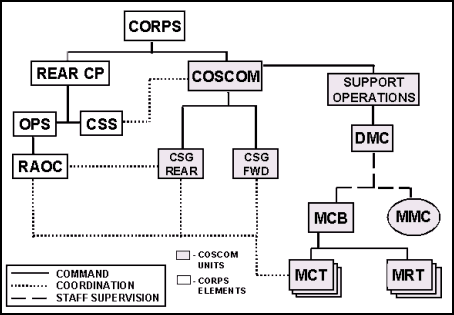
Figure 14-12. Corps Movement Control